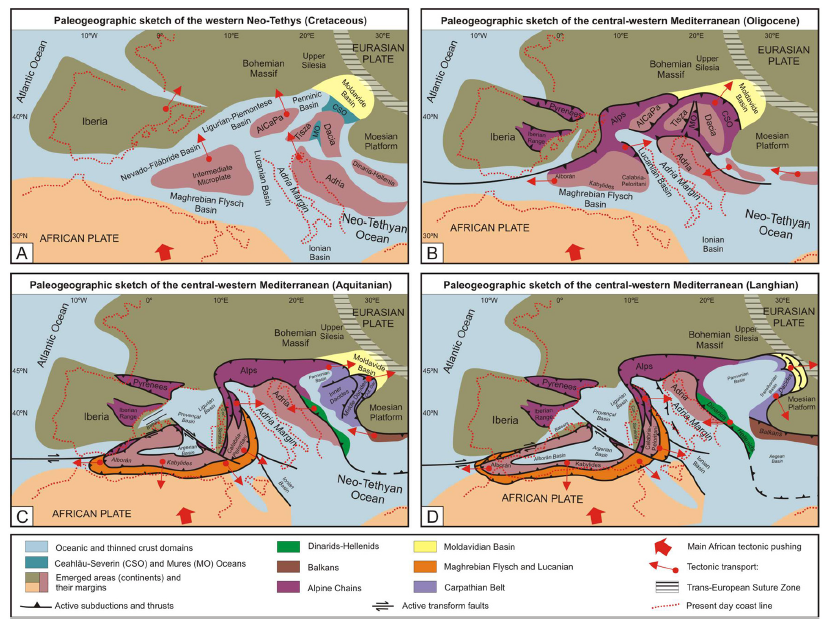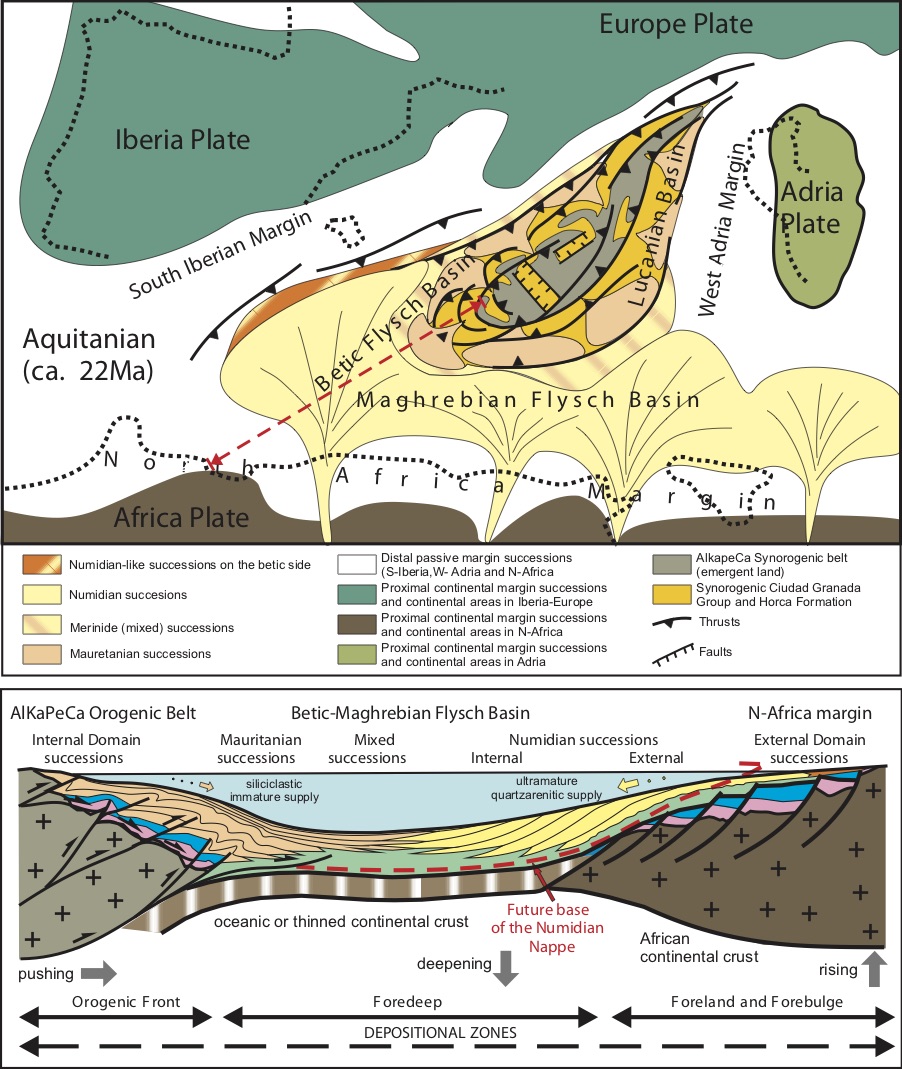Oligo-Miocene evolution of the Paratethyan branches
A comparison of the stratigraphic record between two different branches of the Tethys is attempted for the first time. This study concerns the main Oligocene-Miocene tectono-sedimentary events in the Cenozoic units of the Moldavidian Basin (Romanian Eastern Carpathians) and the Maghrebian Flysch Basin (Maghrebian Chain and its lateral extension in the Betic and Southern Apennine Chains). Both basins are characterized by three main general Oligo-Miocene successions (internal, mixed, and external) corresponding to three subdomains controlled by the geological evolution of opposite plate (or microplate) margins and affected by a similar tectonic evolution. The successions of the three subdomains of the two basins show very similar features regarding stratigraphic records (lithofacies and petrofacies associations, unconformities, marker-levels, age), and the space-time sediment supply diversification (i.e., immature and super-mature arenites coming from opposite margins). Furthermore, pre-, syn- and post-orogenic successions have been identified in the geological reconstructions of both basins. The tectonic control on depositional processes (i.e., a large amount of siliciclastic supply confined in restricted time ranges, widespread volcaniclastites linked to acid-intermediate penecontemporaneous volcanic activity), and the appearance of indicators of syn-sedimentary tectonic activity (turbidites, slumps, and olistostromes) result in correlable events related to deformation phases that in turn are indicative of a similar evolution. Also, the basinal evolutionary stages (i.e., beginning of terrigenous supply, thrust-top basin formation and gravitational sliding, molassic and/or intramontane sedimentary cycles), the timing of deformation phases (drifting, foredeep), and geotectonic events (from extension to compression and post-orogenic deformation) seem to be similar. All results are encompassed in an evolutionary geodynamic model considered in the context of the Africa-Europe convergence where intermediate microplates are involved. This complex framework implies a progressive reorientation of convergence direction of these microplates that occurs during similar geodynamic events leading to the closure of the western Tethys Ocean and its related late-Alpine branches. This comparative approach, if applied to similar evolutionary phases of other mountain chains, can be useful for different geological contexts of other orogenic belts, especially to check the major general geological constraints for their evolution.

New model for the Betic Flysch Basin
The Flysch Complex extends, with equivalent stratigraphic and tectonic features, from the Betic Cordillera to the Rif, Argelian and Tunisian Tells, Sicily, Calabria and the southern-central Apennines. In the Betic Chain, it extends from the Campo de Gibraltar to the Vélez Rubio-Lorca region. This complex is a thrust-and-fold system (when structurally organised) or a tectonosedimentary mélange (when showing a rather chaotic structure). In the western Betic Cordillera, the Campo de Gibraltar Flysch Complex widely overthrusts the External Zones and, in turn, the Alborán Domain (Frontal Units in particular) thrusts onto it.
The Flysch Complex is mainly made of Lower Cretaceous to lower Burdigalian turbiditic siliciclastic (and subordinately carbonatic) sandstones interlayered with varicoloured clays. Since the latest Oligocene the successions show synorogenic character.
The Cretaceous successions of the Alborán (internal domain in the figure) domain record the post-rift evolution of the proximal to distal parts of a divergent Tethyan paleomargin, while those of the Campo de Gibraltar Flysch Complex record the evolution of the oceanic basin. The Alborán and the Campo de Gibraltar Flysch Complex domains were later transformed into a convergent continental margin (Oligocene to Early Miocene) that later evolved to a collisional setting (Middle to Late Miocene).

Jimenez de Cisneros exhibition at Crevillent
In the Crevillent town takes place an exhibition on the geologist Daniel Jimenez de Cisneros celebrating the 100 years of the publication of the first geological study of the Crevillent Sierra.
The University of Alicante has been collaborating in the exhibit 15-years after the 2004-tribute-simposium to Don Daniel Jimenez de Cisneros. The link bellow show two videos made for the event.
Catoon trailer:
link to the facsimil-book published:
Recent Comments